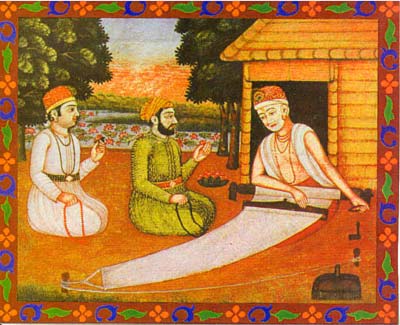Dharma is the path of righteousness and living one's life according to the codes of conduct as described by the Hindu Scriptures.
Hinduism describes dharma as the natural universal laws whose observance enables humans to be contented and happy, and to save himself from degradation and suffering. Dharma is the moral law combined with spiritual discipline that guides one's life. Hindus consider dharma the very foundation of life. It means "that which holds" the people of this world and the whole creation. Dharma is the "law of being" without which things cannot exist.
Dharma is one of the most important themes within Hinduism. One often sees dharma translated as religion, duty, or even righteousness, but in fact, there is no single direct translation for dharma. Religion, duty and righteousness are not wrong; they are simply included within the idea of dharma. The word "dharma" comes from the Sanskrit root dhri, meaning to "uphold" or to "sustain." From this perspective, the best way to think of dharma is to say, "that which upholds or sustains the positive order of things: the nation, the community, the family and ultimately even the universe."
According to S. N. Goenka, teacher of Vipassana Meditation, the original meaning of dhamma is "dhareti iti dharmma", or "that which is contained". Dharma in the Buddhist scriptures has a variety of meanings, including "phenomenon" and "nature" or "characteristic".
Dharma also means "mental contents," and is paired with citta, which means heart-mind.
The pairing is paralleled with the combining of kaya (body) and vedana (feelings or sensations which arise within the body but are experienced through the mind), in major sutras such as the Mahasatipatthana sutra.
Dharma is also used to refer to the teachings of the Buddha, especially the discourses on the fundamental principles (such as the Four Noble Truths and the Noble Eightfold Path), as opposed to the parables and to the poems.
Qualities of Buddha Dharma
The Teaching of the Buddha also has six supreme qualities:
1.Svakkhato (Pali) The Dharma is not a speculative philosophy, but is the Universal Law found through enlightenment and is preached precisely. Therefore it is Excellent in the beginning (Sīla — Moral principles), Excellent in the middle (Samadhi — Concentration) and Excellent in the end, the only end that could result through fate. (Pańña — Wisdom).
2.Saditthiko (Pali) The Dharma can be tested by practice and therefore he who follows it will see the result by himself through his own experience.
3.Akāliko (Pali) The Dharma is able to bestow timeless and immediate results here and now, though no matter which means of travel, for which there is no need to wait until the future or next existence.
4.Ehipassiko (Pali) The Dharma welcomes all beings to put it to the test and to experience it for themselves.
5.Opāneyiko (Pali) The Dharma is capable of being entered upon and therefore it is worthy to be followed as a part of one's life.
6.Paccattam veditabbo viññūhi (Pali) The Dharma may be perfectly realized only by the noble disciples (Pali: Ariyas) who have matured and who have become enlightened in supreme wisdom.
Knowing these attributes, Buddhists hold that they will attain the greatest peace and happiness through the practice of Dharma. Each person is therefore fully responsible to engage in their own practice and commitment.(Source:Wikipedia)
“Dharma” means “protection”. By practising Buddha’s teachings we protect ourself from suffering and problems. All the problems we experience during daily life originate in ignorance, and the method for eliminating ignorance is to practise Dharma.(from web)






0 Comments